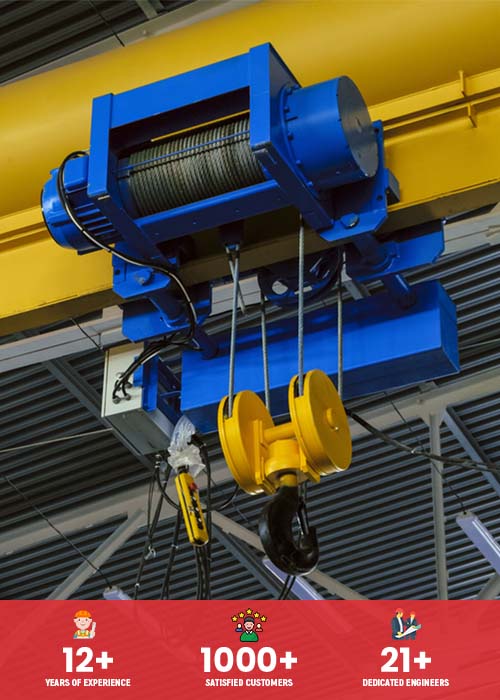What are the best ways to maintain overhead cranes and hoists safely?
Overhead cranes play a pivotal role in transferring loads in a factory. Without these cranes, it would be difficult for a factory to manage its operations in a hassle-free way. Over the last few years, the demand and usage of overhead cranes have increased exponentially. An overhead crane is a type of equipment that consists of two parallel beams. These beams are used to transport cargo from one place to another inside a factory. These cranes are extensively used in maintaining various applications such as warehouses, workstations, garage workshops, etc. The two beams of the crane used to support it in moving the load either side to side or forward & backwards.
Many reputed EOT crane manufacturers in Ahmedabad are welcoming the clients with various types of cranes such as overhead bridge cranes, overhead gantry cranes, jib cranes, and many more. Different cranes come with different technical features, complications, intricacies, advantages, and disadvantages.
An overhead crane is much bulkier and heavier than you think. Without following proper safety measures and visual examinations, a person is unable to operate a crane. Even if a tiny mistake occurs, the much heavier overhead crane will cause damage or injuries to people.
Hoist safety and precautions
Before operating an overhead crane, a person should have adequate knowledge about the important tips and tricks. Before starting the safety inspection, an operator should thoroughly check the below-mentioned potential safety hazards.
· An overhead crane should be operated with skilful, experienced and trained employees. People who don’t have adequate knowledge about the crane should stay away from operating a crane. Because any small mistake can lead up to the losing lives of people.
· You should consider the crane loading condition to avoid a load moment. This can overturn the crane.
· “Hoist danger” signs should be placed around the operational area. No worker and staff should stand or work beneath the hoist area.
· While operating an overhead crane, proper cautions and measures of safety length of people should be maintained.
· You should opt for a professional inspection of the load/stress-bearing structure at least annually. Also, submit the reports for the crane file.
· When a hoist or overhead trolly is travelling, don’t swing a crane or grab or hook.
· When the crane is in the operating phase, select those items on the crane that could potentially fall.
· The crane with the operator cabin should possess a fully-charged fire extinguisher.
· Check the bridge and trolley whether they are on track and functioning properly or not.
· Never compromise with the safety of the people. That’s why always guard the moving parts of the crane.
· A crane’s stability depends on the ground’s quality and levelling for optimal rotation and operation. Some parameters like the boom’s angle, the load weight, and the radius to the load gravity also determine the stability of the crane.
· Make sure that the load can travel without inhibitions.
· Never leave the load ignored.
Proper safety and maintenance
You should follow the below-mentioned steps as preventive methods to guarantee safety.
· To ensure safety, inspections of worn or cracks in the wielded area should be checked.
· Before using, check the hook roller brackets, welds, locking devices, bearings, pins, shafts, gears, and removable outrigger attachment.
· Before starting check all brakes (the bridge and trolley motor brakes).
· Don’t forget to check the main chords and lacings.
· Check whether the bridge and trolley motor brakes are functioning properly or not. Do cross-check if all the below-the-hook devices are in good condition or not.
· Test proper calibration on all indicators.
· The correct response of brakes, motion lever, and locking devices must be checked. Never ignore the accuracy of the rated capacity indicator (RCI) or load moment indicator (LMI).
· You should inspect the crane periodically. This includes loose, missing bolts, pins or nuts, cracked, worn or distorted parts.
· Pay extra care and attention to the hook block. This will help you to get an idea of whether the wire rope and load chain are in the right positions or not. If they are not in the proper positions, fix their positions immediately.
· When the crane is in motion, the operator should be attentive.
· Always ensure that there is no kinking, cutting, crushing, un-stranding or thermal damage to the wire rope. Check whether all chain sprockets are operating effortlessly or not.
· The safety should be checked or inspected by professionals who have in-depth knowledge regarding this field.
Every crane should be maintained and inspected properly as per the recommendations of manufacturers. If not maintained properly, serious damages can happen. If any malfunction or unusual sound is observed, stop the crane immediately.
Krishna Crane Engineers is a reputed EOT crane manufacturer in Ahmedabad that are specialized in crane and hoist manufacturing. The company can successfully meet the demand of the customers from various fields including Manufacturing industries, Shipping yards, ports, Construction companies, Transport and logistics companies. You should visit the website of the company to know more about it and its products.




